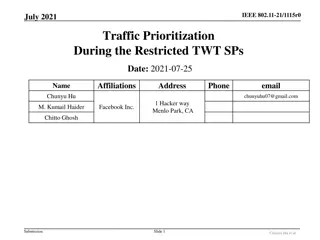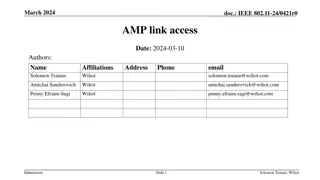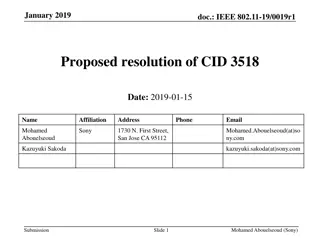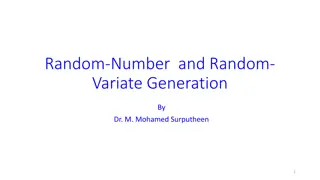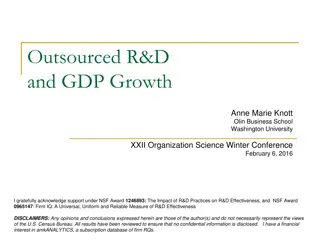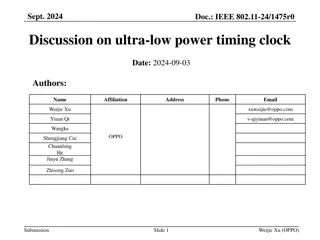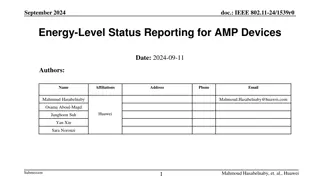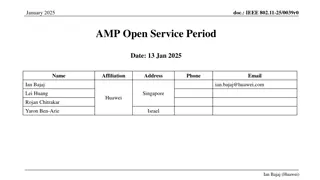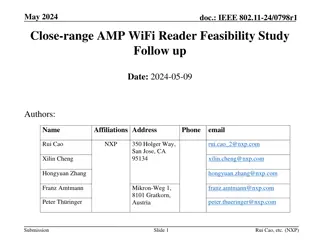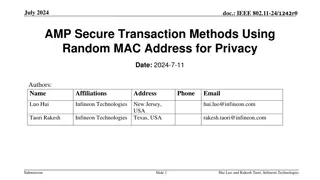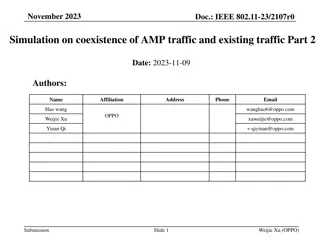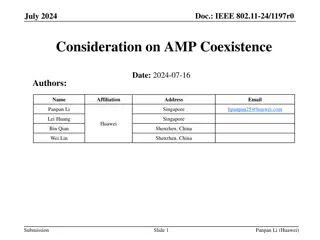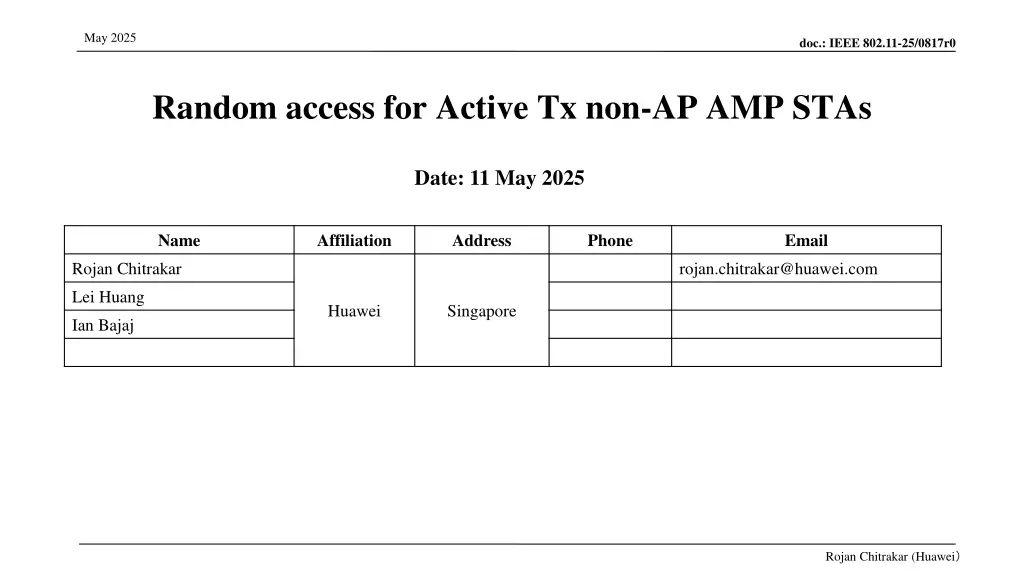
IEEE 802.11-25 Recap on Time-Slot-Based Random Access Procedure
Explore the detailed recap of the IEEE 802.11-25 document on time-slot-based random access for Active Tx non-AP AMP STAs. The document covers random access procedures, uplink channel access, data rates, and more related to wireless medium access. Learn about the key points and procedures outlined in the IEEE 802.11-25 specification for efficient wireless communication.
Download Presentation

Please find below an Image/Link to download the presentation.
The content on the website is provided AS IS for your information and personal use only. It may not be sold, licensed, or shared on other websites without obtaining consent from the author. If you encounter any issues during the download, it is possible that the publisher has removed the file from their server.
You are allowed to download the files provided on this website for personal or commercial use, subject to the condition that they are used lawfully. All files are the property of their respective owners.
The content on the website is provided AS IS for your information and personal use only. It may not be sold, licensed, or shared on other websites without obtaining consent from the author.
E N D
Presentation Transcript
May 2025 doc.: IEEE 802.11-25/0817r0 Random access for Active Tx non-AP AMP STAs Date: 11 May 2025 Name Affiliation Address Phone Email Rojan Chitrakar rojan.chitrakar@huawei.com Lei Huang Huawei Singapore Ian Bajaj Rojan Chitrakar (Huawei
May 2025 doc.: IEEE 802.11-25/0817r0 Selected motions related to Uplink channel access MM-6: 802.11bp to define a slot-based procedure to enable one or more clients to access the medium to send uplink AMP PPDU(s). MM-8: An 802.11bp client may use the receive time of the AMP Trigger frame, which solicits UL AMP PPDUs from the client, to determine the timing for transmitting UL AMP PPDUs in the same TXOP The definition of receive time is TBD. MM-10: 802.11bp supports a time-slot based random access mechanism for Active Tx non-AP AMP STAs: AMP AP transmits an AMP frame that indicates one or more time-slots. Further details (e.g., frame formats, how a STA chooses a random access time-slot etc.) are TBD. PM-9: The AMP Downlink PPDU in 2.4 GHz shall support the following data rates: 1 Mb/s (for non-Backscatter STAs only) 250 kb/s. PM-17: 11bp defines the following data rates for AMP uplink transmissions at 2.4GHz 250kbps and 1Mbps for both backscatter and non-backscatter uplink transmission; 4Mbps for non-backscatter uplink transmission only. Mandatory or optional is TBD Rojan Chitrakar (Huawei Slide 2
May 2025 doc.: IEEE 802.11-25/0817r0 Recap: Time-slot based random access (1/2) [6] Random access procedure: 1. The AMP AP gains access to wireless medium and transmits a first AMP frame (e.g., an AMP Poll frame) to start a random access session. The frame indicates: Session ID: Identifies the random access session The number of slots allocated by the frame The total number of random access slots = 2ECW Solicited Response Type(s) (e.g., ID, Sensor Data etc.) 2. Upon receiving an AMP Poll frame, a non-AP AMP STA randomly choose a slot in the range [0, 2ECW - 1]. 3. The AMP AP may transmit a second AMP frame (e.g., an AMP Re-Poll) to continue the random access session (either in the same TXOP or in a different TXOP) and indicates: The range of slots allocated by the frame Session ID: Identifies the random access session 4. The non-AP AMP STA transmits an uplink AMP PPDU carrying the solicited response in the selected slot. Rojan Chitrakar (Huawei Slide 3
May 2025 doc.: IEEE 802.11-25/0817r0 Recap: Time-slot based random access (2/2) [6] Random access procedure: 5. Upon detecting failed reception in a slot (e.g., due to collisions, or other interference), the AMP AP initiates a selective random access retransmission procedure by transmitting a third AMP frame (e.g., AMP ReTx-Poll frame): The total number of random access slots = 2ECW Session ID: Identifies the random access session The number of slots allocated by the frame NACK Slot Index List: Index of slot or slots for which retransmission is solicited. Only the AMP non-AP STAs that had transmitted in a slot indicated in the NACK Slot index List will participate in the retransmission random access session. = Slot 1 Rojan Chitrakar (Huawei Slide 4
May 2025 doc.: IEEE 802.11-25/0817r0 Time-slot based random access Key Points 1) Due to the low downlink data rates, frequent downlink transmissions cause high air-time overhead. As an example, a 7-octets AMP frame (e.g., an Ack frame) takes 316 S @250 Kbps and 116 S @1Mbps. To avoid lengthening the slot duration, we propose that AMP AP does not transmit Ack frame in each slot during a random access TXOP. Instead, if failed reception is detected in one or more time-slots of a random access TXOP, the AMP AP may initiate another random access for selective retransmissions. 2) For the same reason, we also propose that guard intervals are used to minimize inter-slot collisions due to early or late start of uplink transmissions caused by non-AP AMP STAs clock drift (i.e., AMP AP does not transmit any downlink signal to indicate the start of a time-slot). To avoid large accumulation of clock drift at the non-AP AMP STA during a random access TXOP, the AMP AP may transmit another AMP Trigger frame (e.g., an AMP Re-Poll frame) within a random access TXOP. Rojan Chitrakar (Huawei Slide 5
May 2025 doc.: IEEE 802.11-25/0817r0 Time-slot based random access Random access procedure (An example): AMP Trigger frame that initiates an random access with a total of 16 slots; out of which 8 slots are allocated by the frame. AMP Trigger frame that initiates a random access for selective retransmission for non-AP AMP STAs that transmitted in slot#15. AMP Trigger frame that continues the random access and allocates the remaining 8 slots. Rojan Chitrakar (Huawei Slide 6
May 2025 doc.: IEEE 802.11-25/0817r0 AMP Trigger frame Similar to the views expressed in [3], [4], we propose that AMP frame be designed similar to WUR frames, only carrying the absolutely essential fields. The parameters to be carried in the AMP Trigger frame will be different for random access and scheduled access. In order to keep the frames compact, we propose to define different sub-types of the AMP Trigger frame, e.g., AMP Poll, AMP Re-Poll, AMP ReTx-Poll for random access and AMP Request for scheduled access. Frame Sub-type Name Description 0 AMP Poll AMP Trigger frame to initiate a new random access session. 1 AMP Re-Poll AMP Trigger frame to continue a random access session. One AMP Frame Type (AMP Trigger) may be used to initiate time-slot based channel access 2 AMP ReTx-Poll AMP Trigger frame to initiate a random access session for retransmission. Frame Type Name Description 0 AMP Trigger AMP frame to solicit a response from non-AP AMP STAs either during random access or scheduled access. 3 AMP Request AMP Trigger frame for scheduled access. Rojan Chitrakar (Huawei Slide 7
May 2025 doc.: IEEE 802.11-25/0817r0 AMP Trigger frame: AMP Poll The AMP AP gains access to wireless medium and transmits the AMP Poll frame to start a random access session. The frame indicates: Session ID: Identifies the random access session Response Type: Type of the solicited uplink response e.g., ID, Sensor Data etc. ECW: The total number of random access slots = 2ECW o Allows up to 256 slots Number of Slots: The number of slots immediately after the AMP Poll frame that are allocated for uplink transmissions. Omitted if the value is equal to 2ECW Slot Duration: Duration of each time-slot. Rojan Chitrakar (Huawei Slide 8
May 2025 doc.: IEEE 802.11-25/0817r0 AMP Trigger frame: AMP Re-Poll The AMP AP transmits the AMP Re-Poll frame to continue a random access session, either in the same TXOP (to correct clock-drift*) or a in new TXOP (to spread the slots across TXOPs). The frame indicates: Session ID: Identifies the random access session Slot Range: The index of the first slot and the number of slots immediately after the AMP Re-Poll frame that are allocated for uplink transmissions Note1: The other parameters (Response Type, Slot Duration) are assumed to be same as the random access session indicated by the Session ID. Note2: The non-AP AMP STAs use the receive time of the AMP Re-Poll frame to determine the start time of the time-slots that follow the AMP Re-Poll frame. Rojan Chitrakar (Huawei Slide 9
May 2025 doc.: IEEE 802.11-25/0817r0 AMP Trigger frame: AMP ReTx-Poll The AMP AP gains access to wireless medium and transmits the AMP ReTx-Poll frame to initiate selective random access retransmission. The frame indicates: Session ID: Identifies the random access session for which retransmission is solicited. ECW: The total number of random access slots for retransmission = 2ECW Number of Slots: The number of slots immediately after the AMP ReTx-Poll frame that are allocated for uplink transmissions. Omitted if the value is equal to 2ECW NACK Slot Index List: Identifies one or more slots of the random access session for which retransmission is solicited. Note: The other parameters (Response Type, Slot Duration) are assumed to be same as the random access session indicated by the Session ID. Rojan Chitrakar (Huawei Slide 10
May 2025 doc.: IEEE 802.11-25/0817r0 Summary We discussed the details of the random access for active Tx non-AP AMP STAs and proposed different sub-types of the AMP Trigger frame for random access: AMP Poll: AMP Trigger frame to initiate a new random access session. AMP Re-Poll: AMP Trigger frame to continue a random access session, either in the same or a different TXOP. AMP ReTx-Poll: AMP Trigger frame to initiate a selective random access retransmission. Rojan Chitrakar (Huawei Slide 11
May 2025 doc.: IEEE 802.11-25/0817r0 SP 1 Do you agree to add to 11bp SFD: An AMP AP transmits a first variant of the AMP Trigger frame to start a time-slot based random access session for non-AP AMP STAs. The frame carries one or more of: o Session ID: Identifies the random access session o Response Type: Type of the solicited uplink response o ECW: Indicates the total number of slots in the random access session o Number of Slots: The number of slots immediately after the AMP Poll frame that are allocated for uplink transmissions o Other parameters are TBD. o Name of the AMP Trigger frame variant is TBD. Rojan Chitrakar (Huawei Slide 12
May 2025 doc.: IEEE 802.11-25/0817r0 SP 2 Do you agree to add to 11bp SFD: Upon receiving the first variant of the AMP Trigger frame that starts a time-slot based random access session, a non-AP AMP STA performs the following actions: o Randomly chooses a slot in the range [0, 2ECW - 1]. o If the chosen slot is within the slots allocated by the AMP Trigger frame, the non-AP AMP STA transmits an uplink AMP PPDU carrying the requested response in the slot. Rojan Chitrakar (Huawei Slide 13
May 2025 doc.: IEEE 802.11-25/0817r0 SP 3 Do you agree to add to 11bp SFD: An AMP AP may transmit a second variant of the AMP Trigger frame to continue a time-slot based random access session. The frame carries one or more of: o Session ID: Identifies the random access session o Slot Range: The index of the first slot and the number of slots immediately after the AMP Re- Poll frame that are allocated for uplink transmissions o Other parameters are TBD. o Name of the AMP Trigger frame variant is TBD. Rojan Chitrakar (Huawei Slide 14
May 2025 doc.: IEEE 802.11-25/0817r0 SP 4 Do you agree to add to 11bp SFD: Upon receiving the second variant of the AMP Trigger frame that continues a time- slot based random access session, a non-AP AMP STA that had chosen a slot in the random access session, performs the following actions: o If the chosen slot is within the slots allocated by the AMP Trigger frame, the non-AP AMP STA transmits an uplink AMP PPDU carrying the requested response in the chosen slot. Rojan Chitrakar (Huawei Slide 15
May 2025 doc.: IEEE 802.11-25/0817r0 SP 5 Do you agree to add to 11bp SFD: An AMP AP transmits a third variant of the AMP Trigger frame to start a time-slot based random access session for selective retransmission. The frame carries one or more of: o Session ID: Identifies the random access session for which retransmission is solicited. o ECW: Indicates the total number of slots in the random access session o Number of Slots: The number of slots immediately after the AMP ReTx-Poll frame that are allocated for uplink transmissions o NACK Slot Index List: Identifies one or more slots of the random access session for which retransmission is solicited o Other parameters are TBD. o Name of the AMP Trigger frame variant is TBD. Rojan Chitrakar (Huawei Slide 16
May 2025 doc.: IEEE 802.11-25/0817r0 SP 6 Do you agree to add to 11bp SFD: Upon receiving the third variant of the AMP Trigger frame that starts a selective random access retransmission, a non-AP AMP STA that had transmitted in a slot of the random access session for which retransmission is solicited, and the index of the slot is indicated in the NACK Slot Index List, performs the following actions: o Randomly chooses a slot in the range [0, 2ECW - 1] and transmits an uplink AMP PPDU carrying the requested response in the chosen slot. Rojan Chitrakar (Huawei Slide 17
May 2025 doc.: IEEE 802.11-25/0817r0 References [1] 25/0046r0, Channel access for Active Tx non-AP AMP STAs (Rojan Chitrakar et. al.) [2] 24/1776r1, Multiple access mechanisms for AMP (Chuanfeng He et. al.) [3] 24/1811r0, Frame format discussion (Liwen Chu et. al.) [4] 11-24/1537r2, Wireless connectivity challenges for AMP only IoT devices under 802.11 specification (Solomon Trainin) [5] 11-25/252r0, Slotted vs Pure Aloha for Active Transmitter AMP Use Cases (Amichai et. al.) [6] 25/0334r1, Channel access for Active Tx non-AP AMP STAs follow up (Rojan Chitrakar et. al.) Rojan Chitrakar (Huawei Slide 18



